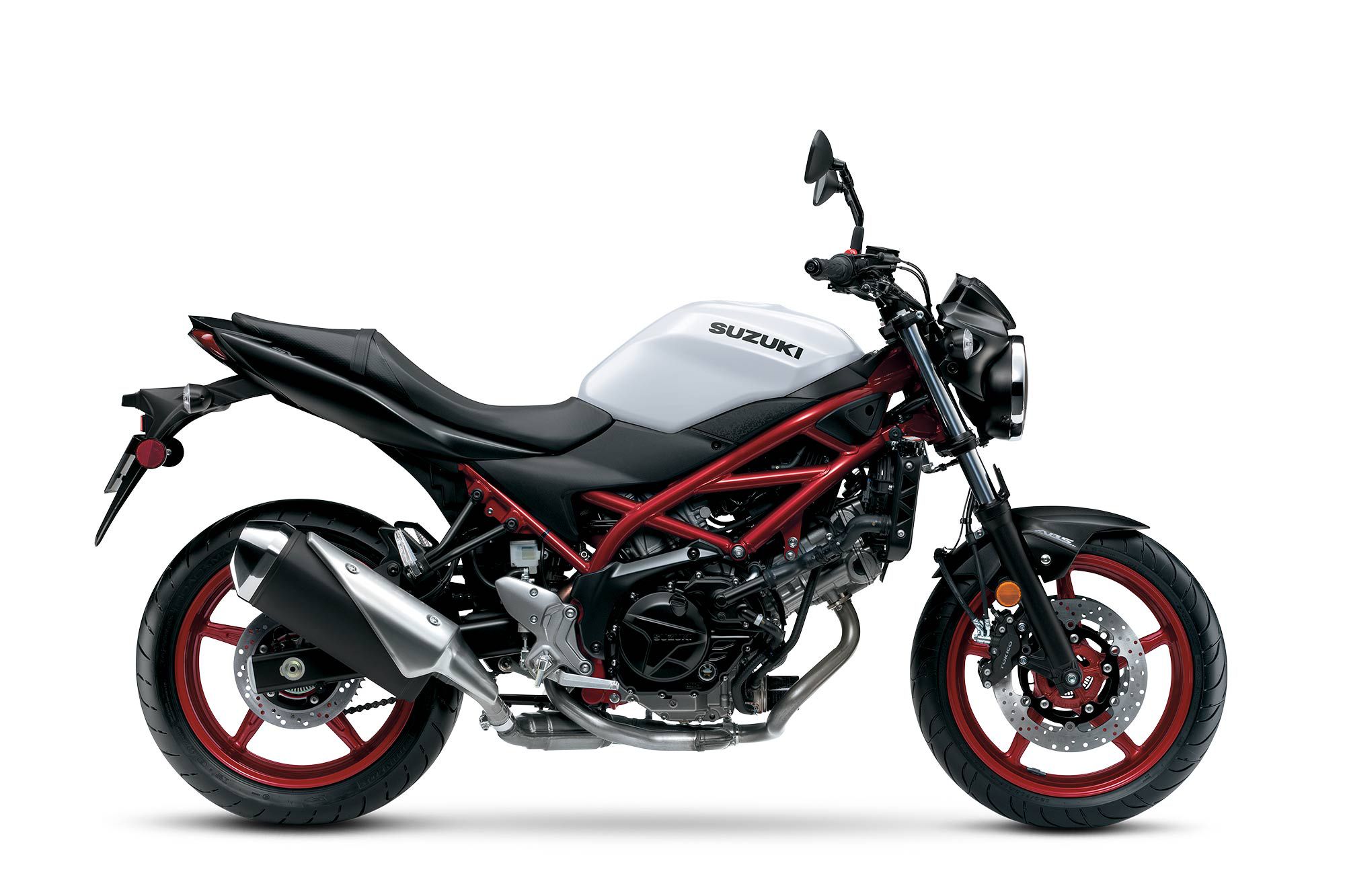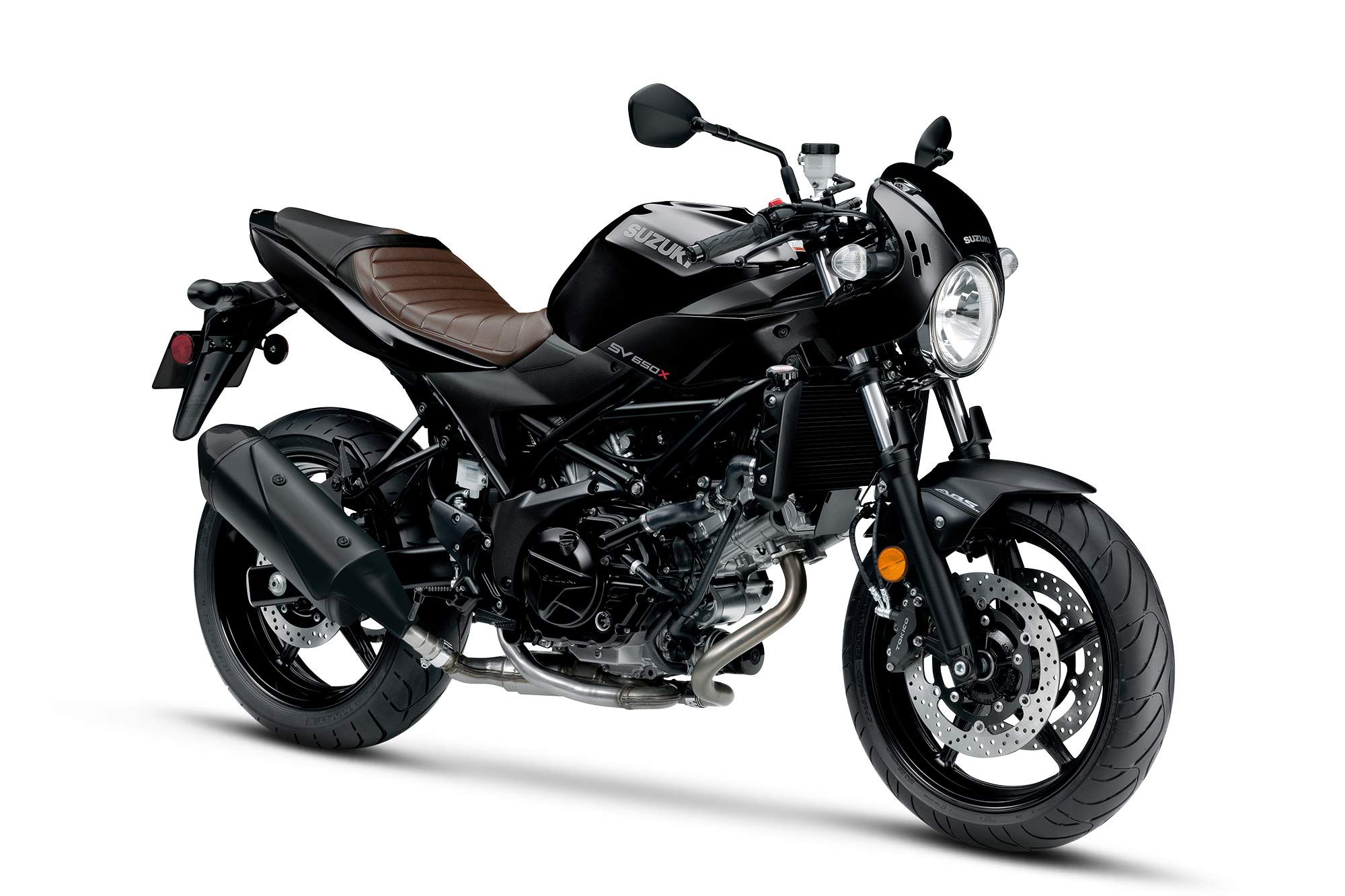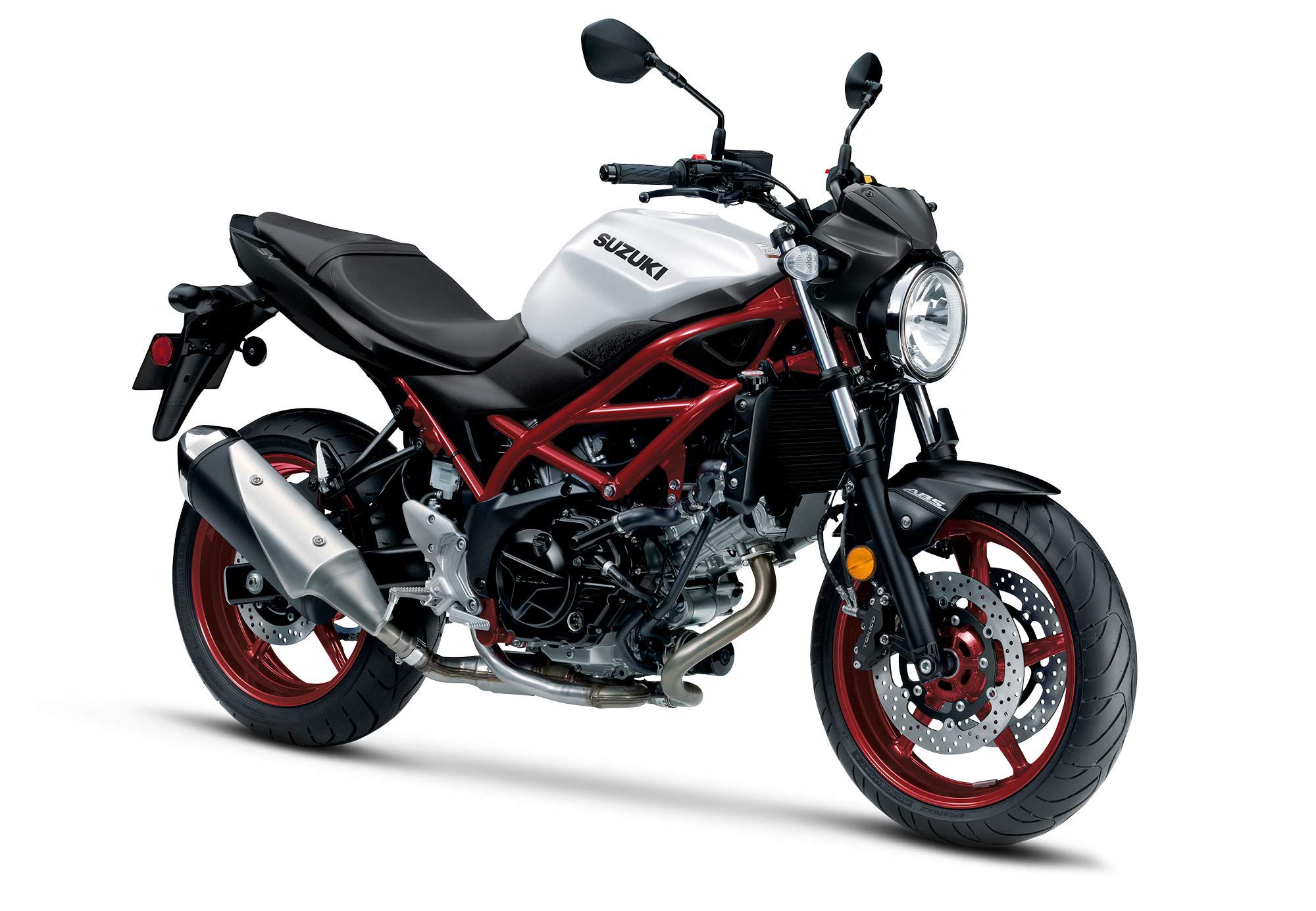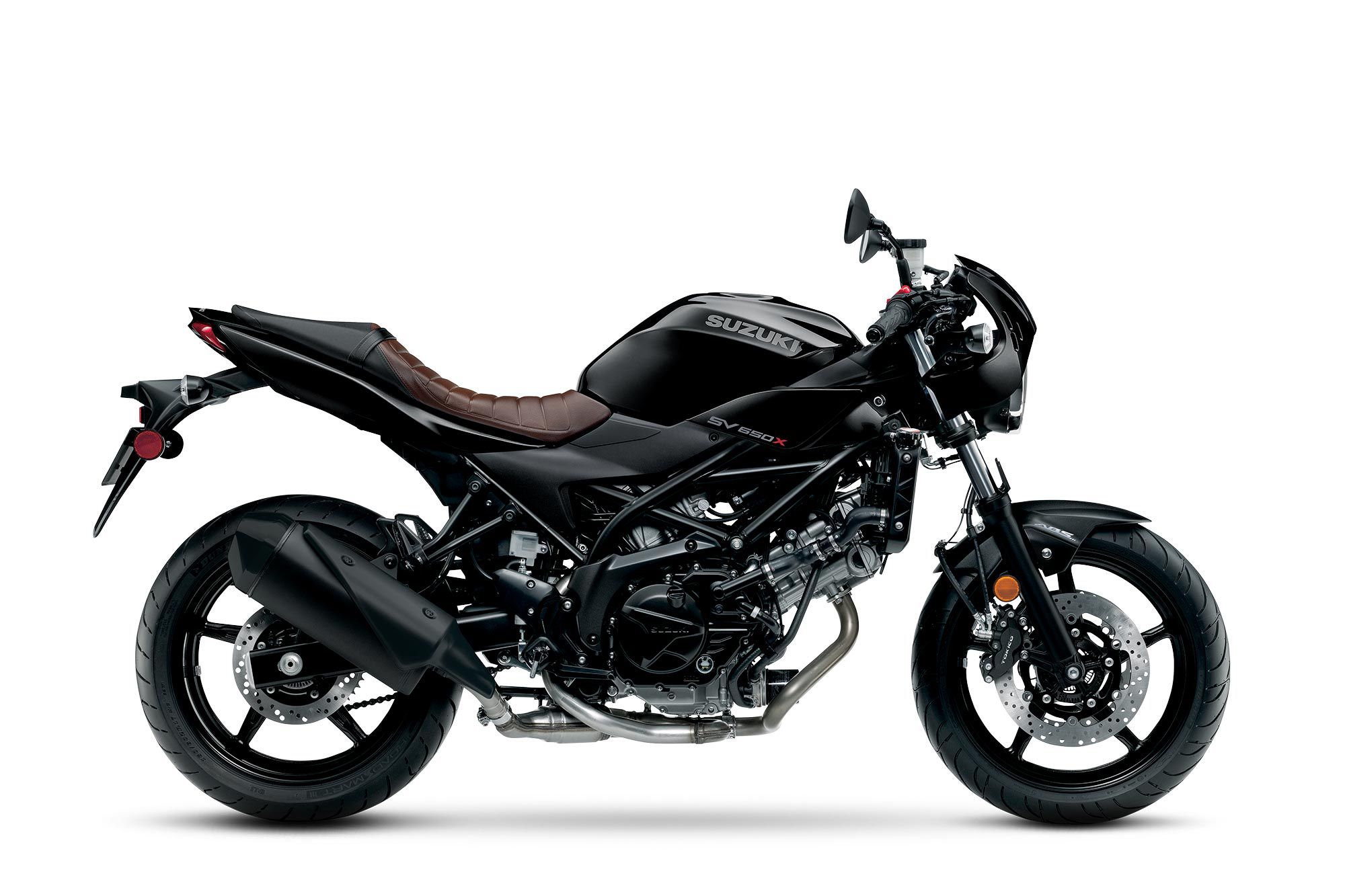
Ups
- Low sticker price
- Friendly yet peppy engine
- Good solid chassis
Downs
- Design is showing its age
- A little heavy
- Front brake’s wooden response, numb feel
Verdict
Although it’s been usurped by newer competition, the SV650 is still a solid choice for those looking for accessible performance on a budget. The Suzuki’s advancing age is beginning to show, however.

Overview
Ever since its 1999 debut, the SV650 has been one of Suzuki’s top sellers by virtue of its combination of good performance and low sticker price. It still has the friendly character that makes the V-twin so appealing to entry-level riders, while offering the twisty-pavement capabilities that have earned it a loyal following among sportbike riders and club racers. In 2009, the model was renamed Gladius, along with a different chassis and styling alterations that added weight. The Gladius was eventually dropped in 2016, with a return to the SV’s original name and core styling roots, using numerous engine and chassis updates that boosted power while passing Euro 4 emissions. A cafe-racer SV650X version with different seat/tank/headlight and clip-on bars was released in 2019 (read a CW review of that model here).
Updates for 2021
There are no updates to the SV650 other than new colorways. The 2021 SV650 ABS is available in Pearl Brilliant White/Glass Sparkle Black (the mechanically identical 2022 model will come in Metallic Matte Black No. 2), while the SV650X comes in Glass Sparkle Black as a 2020 model. The standard SV650 is available as a 2020 model in Metallic Mystic Silver.
Pricing and Variants
The SV650 ABS is available in a 2021 model for $7,699, with the 2022 model retailing for $7,749. The standard SV650 is available in the 2020 model at $7,099 and the 2022 model at $7,299. The SV650X is currently available as a 2020 model for $8,399.
Competition
The middleweight naked bike category has seen sales rise substantially over the past decade, and the list of competitors for the SV650 is getting larger. Bikes that could be cross-shopped with the Suzuki include the Honda CB650R, Kawasaki Z650, and the Yamaha MT-07. If you’re not that concerned with price, other options include the Aprilia Tuono 660 and the Triumph Trident 660. You can check out an archived comparison test of the Suzuki SV650, Kawasaki Z650, and Yamaha MT-07 here.
Powertrain: Engine, Transmission, and Performance
The 645cc liquid-cooled DOHC 90-degree V-twin’s basic architecture has stayed the same, although the engine was significantly updated in 2016. When CW ran a 2019 SV650X on the dyno (all the SV650 models share the same engine), we saw 68.2 hp at 8,890 rpm, with a peak torque reading of 42.9 pound-feet at 8,170 rpm. The engine has a smooth throttle response and low-end power (along with a low-rpm assist function that helps prevent stalling on takeoff) that helps entry-level riders (read new rider Serena Bleeker’s review of the SV650X here), yet still has plenty of midrange power to easily keep an experienced rider entertained (read Motorcyclist’s review of the SV650 here).

Handling
Superb handling has always been one of the SV650′s strengths, combining agility with confidence-inspiring stability. “Steering is neutral in feel and (provides) a very trusting sense of stability when encountering some rough road surface at speed. Flicking through side-to-side corner transitions just doesn’t get much more intuitive than this,” CW’s Don Canet said in his First Ride Review of the 2017 model. Despite the suspension’s minimal adjustability, “…the spring and damping rates are well chosen, keeping the chassis nicely under control at a rapid pace in the twisty pavement sections without being too stiff at lower speeds on imperfect urban tarmac,” Kent Kunitsugu said in his First Ride Review here.
Brakes
If there’s one weakness with the SV650, it’s the Suzuki’s brakes. Although the brake calipers were finally upgraded from the original 1999 two-piston slide-pin calipers to Tokico four-piston units in 2019, the brake response is still a bit muted and feel is numb compared to most modern brake systems. A set of aftermarket brake pads will probably help here.
Fuel Economy and Real-World MPG
The SV650X recorded an average of 60.2 mpg during CW’s 2019-model ride review.
Ergonomics: Comfort and Utility
The SV650 and SV650 ABS both provide a slightly sporty yet comfortable riding position, with a slim seat/fuel tank junction that helps ease planting both feet on the ground at a stop. Claimed seat height is a relatively low 30.9 inches, which adds approachability for less-experienced or shorter-stature riders.
The SV650X has clip-on bars that are lower than the standard handlebar of the other SVs, but your torso isn’t canted excessively forward like a supersport bike, and the faux tuck-and-roll-leather seat is broad and supportive. Passenger accommodations are better than most sport-style bikes.
Electronics
Other than ABS with the SV650 ABS and SV650X, there are no flashy electronic rider aids, full-color dash info displays, or LED lighting. The SV650 is old school, which also helps keep the price down.
Warranty and Maintenance Coverage
All the SV650 models come with Suzuki’s standard one-year, unlimited-mileage warranty. Longer coverage periods with extended benefits are available through Suzuki Extended Protection (SEP).
Quality
The SV650s have good fit and finish overall, but as previously mentioned, the price-conscious design means you won’t find premium components in the bike’s build. There’s a few plastic styling bits (for example, around the headlight and dash) that look cheap and don’t add much.

2021 Suzuki SV650/X/ABS Claimed Specifications
| MSRP: | $7,099 (2020)/$8,399 (2020)/$7,699 |
| Engine: | 645cc, DOHC, liquid-cooled V-twin; 8 valves |
| Bore x Stroke: | 81.0 x 62.6mm |
| Transmission/Final Drive: | 6-speed/chain |
| Fuel Delivery: | SDTV fuel injection w/ 39mm throttle bodies |
| Clutch: | Wet, multiple disc; cable operation |
| Engine Management/Ignition: | Electronic ignition (transistorized) |
| Frame: | Steel-tube trellis chassis |
| Front Suspension: | 41mm Kayaba conventional fork (base, ABS) / 41mm Kayaba conventional fork, spring preload adjustable (X); 4.9 in. travel |
| Rear Suspension: | KYB shock, spring preload adjustable; 5.1 in. travel |
| Front Brake: | 4-piston calipers, dual 290mm discs (w/ ABS, X and ABS models) |
| Rear Brake: | 1-piston slide-pin caliper, 245mm disc (w/ ABS, X and ABS models) |
| Wheels, Front/Rear: | Cast aluminum; 17 x 3.50 in. / 17 x 4.50 in. |
| Tires, Front/Rear: | 120/70ZR-17 / 160/60ZR-17 |
| Rake/Trail: | 25.0°/4.1 in. |
| Wheelbase: | 56.9 in. |
| Ground Clearance: | 5.3 in. |
| Seat Height: | 30.9 in. (base, ABS) / 31.1 in. (X) |
| Fuel Capacity: | 3.8 gal. |
| Wet Weight: | 432 lb. (base) / 437 lb. (X, ABS) |
| Contact: | suzukicycles.com |
Cycle World Tested Specifications
| Seat Height: | 31.1 in. (2019 SV650X) |
| Wet Weight: | 439 lb. (2019 SV650X) |
| Rear-Wheel Horsepower: | 68.2 hp @ 8,890 rpm |
| Rear-Wheel Torque: | 42.9 lb.-ft. @ 8,170 rpm |
| 0–60 mph: | N/A |
| 1/4-mile: | N/A |
| Braking 30–0 mph: | N/A |
| Braking 60–0 mph: | N/A |
Source: MotorCyclistOnline.com
